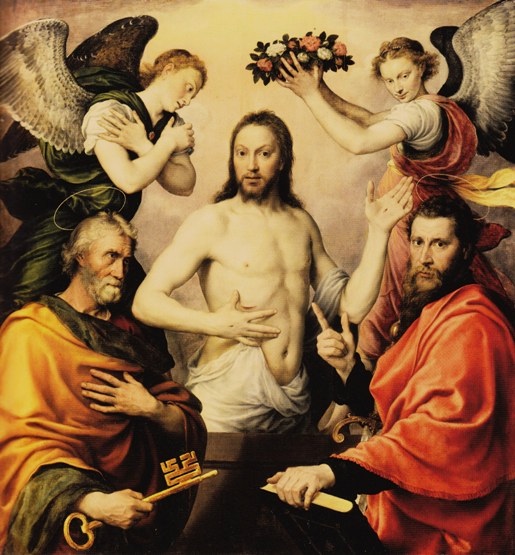Every June 29 we celebrate solemnly Saints Peter and Paul, called traditionally “pillars of the Church,” genuine witnesses of the fulfillment of a mission, with which they identified themselves and consecrated their lives to the point of martyrdom.
In Pope Francis’ words, “they are our travel companions in quest of God; they are our guides in the journey of faith and holiness, they push us to Jesus, to do all that He asks us.”
Benedict XVI proclaimed them “principal Patrons of the Church of Rome,” and stressed that both focus on the message of the holy Gospel.
Saint Peter
A native of Bethsaida, he was born at the end of the 1st century B.C. and died in the year 67 AD. He was also known as Cephas and was a fisherman by trade in the Sea of Galilee.
He is the most mentioned disciple in the New Testament in general, and in the four Gospels and the Acts of the Apostles in particular.
Known as the “Prince of the Apostles,” the Church identifies him as the first Pontiff, based on the words Christ addressed to him: “I tell you, you are Peter, and on this rock, I will build my Church, and the powers of death shall not prevail against it. I will give you the keys of the Kingdom of Heaven, and whatever you bind on earth shall be bound in heaven, and whatever you loose on earth shall be loosed in Heaven” (Matthew 16:18-19). Saint Peter was entrusted with the Petrine function or ministry.
Peter, the fragile and passionate friend of Jesus, who would deny Him three times before He was crucified, is the man chosen by Christ to be “the rock” of the Church. He accepted his mission with humility until the end of his life. His mortal remains rest in Saint Peter’s Basilica in the Vatican, the object of millions of pilgrims from all over the world.
To him is attributed the Gospel of Saint Mark, in as much as the latter was able to collect what the Prince of the Apostles preached and reflect it in his Gospel. Two Epistles are also attributed to him.
Saint Peter ended his days in Rome, where he was Bishop, and died there a martyr. He was buried a short distance from his martyrdom, his place of burial, which was chosen for the building of the Basilica that we enjoy today in the Eternal City.
Saint Paul
Paul of Tarsus, with the Jewish name Saul of Tarsus or Saul, known as Saint Paul. He was born in Tarsus, Cilicia, between 5 and 10 A.D. and died in Rome between 58 and 67 A.D.
Called the “Apostle of the Gentiles.” The “Apostle of the Nations,” or simply “the Apostle.”
He founded several Christian communities and evangelized the most important urban centers of the Roman Empire, such as Antioch, Corinth, Ephesus, and Rome.
Paul, who began persecuting Christians would become, as we stated, the Apostle of the Gentiles, model of evangelizer for all Catholics.
He wrote some of the first Christian canonical writings, including the oldest known, the First Letter to the Thessalonians. Author of the so-called Pauline Letters addressed to Romans, the First and Second to the Corinthians, Galatians, Philippians, Thessalonians, and to Philemon.
It seems he died a martyr, beheaded, according to the apocryphal text written in the year 160, and known under the title Acts of Paul.
Imposition of the Archiepiscopal Palliums
The Petrine function or ministry, which was entrusted to Saint Peter as Roman Pontiff, needs collaborators for the efficacy of the Church’s government, especially in an organization — the ecclesial –, of universal ambit.
Archbishops – Bishops at the head of particularly important dioceses, carry out an essential part of that collaboration. Among them, there are some called “Metropolitan Archbishops,” for being in charge of the ecclesiastical province in which their Archdioceses are located.
Well, every June 29, being the Solemnity of the Apostles Peter and Paul, the Pope blesses the “palliums” destined to the Metropolitan Archbishops.
What is an Archiepiscopal pallium? It’s a white woolen ornament in the shape of a circular strip that he wears on his shoulders, from which hang on the chest and the back two rectangular strips with black or red silk crosses. It symbolizes Archbishops’ power in their realms, and also the bond of communion with the Roman Pontiff.
Up to Saint John Paul II, after blessing a pallium the Pope sent it to each one of the Metropolitan Archbishops appointed in the immediately preceding year, to whom it was imposed in their dioceses.
A new period began with the Polish Pope who invited the new Metropolitans to concelebrate with him in Saint Peter’s Basilica, imposing the pallium on them during the Mass. This custom continued during Benedict XVI’s pontificate and the two first years of Pope Francis’.
Since 2015 the new Metropolitans will be in Rome, will concelebrate the Eucharist with the Holy Father, and participate in the Rite of the Blessing of the Palliums, but there won’t be imposition: they will simply receive from the Holy Father the pallium designated for them in a simpler and more private way, thus signifying their hierarchical communion.
So, to date, the imposition is carried out in the respective Archdioceses by the Apostolic Nuncios — representatives of the Holy See in each State –, to reinforce the Metropolitans’ relationship with their local Church and make it possible for their faithful to take part in the ceremony.
Alejandro Vazquez-Dodero, Doctor in Canon Law
Translation by Virginia M. Forrester










